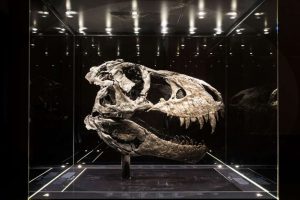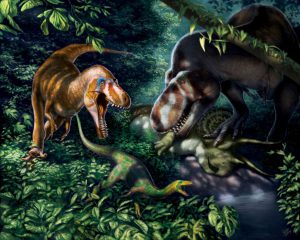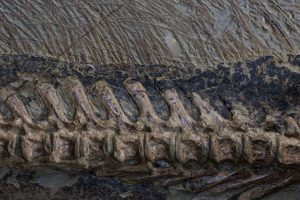JANUARY 1, 2020

This nearly whole, deep-black skull belongs to the most complete specimen of Tyrannosaurus rex on display in Europe, an individual nicknamed Tristan Otto. With 170 of its 300-odd bones preserved, this scientifically important but privately owned skeleton is currently at the Museum für Naturkunde in Berlin, Germany. Discovered in 2010 in Montana’s famed Hell Creek Formation of the late Cretaceous, the 40-foot-long fossil took four years to excavate and prepare.
Sixty-six million years ago, the ground of western North America trembled with the footfalls of a tyrant: Tyrannosaurus rex. But despite a wealth of T. rex remains pulled from the region’s Cretaceous-period rocks, scientists have had few clues about how the celebrity dinosaur grew from a hatchling to a gargantuan predator—until now.
In a study published in Science Advances on Wednesday, researchers reveal a stunningly detailed analysis on cross-sections of bone from juvenile tyrannosaurs. The results suggest that T. rex’s growth rates varied as it aged, and that these predatory dinosaurs could seemingly slow their growth when food was scarce, potentially giving them an evolutionary leg up. (Also find out about “Scotty,” the biggest T. rex discovered to date.)
The research also casts further doubt on the existence of Nanotyrannus, a controversial “pygmy” tyrannosaur proposed to have lived alongside T. rex. In the 1980s, paleontologists examining a set of small, slender carnivores concluded that the Cretaceous fossils belonged to their own distinct tyrannosaur species. However, subsequent studies have led most experts to agree that the fossils assigned to Nanotyrannus are probably juvenile T. rex.
The new study offers the first hard data on the small-scale structure of some purported Nanotyrannus bones, confirming that two candidate fossils are in fact juveniles. So, either an adult Nanotyrannus hasn’t been found yet—or Nanotyrannus really is a teenage T. rex. In the latter case, the fossils offer a rare glimpse at an important developmental stage in the life of this dinosaur icon.
“There’s still a lot to learn about dinosaurs, even a dinosaur as famous as Tyrannosaurus rex,” says lead study author Holly Woodward, a paleontologist at the Oklahoma State University Center for Health Sciences. “We still know very little about its life history: how it grew up from hatching out of an egg to a 9,000-kilogram beast.”
‘Fossil unicorn’
Previous studies of adult T. rex showed that the dinosaur grew to a massive size by the time it reached its mid-20s. In two influential 2004 papers, researchers suggested that it went through a growth spurt in its teenage years, putting on an average of five pounds a day. But analyzing elderly T. rex can’t provide the whole story. As bones grow, they constantly remake themselves, which gradually erases the bone laid down in childhood.
“We know that [T. rex] had to grow fast to go from a hatching probably no bigger than a pigeon into an adult larger than a bus, but we don’t know a lot about how it grew during its teenage years,” Steve Brusatte, a paleontologist at the University of Edinburgh who reviewed the study, says in an email.
Enter Woodward, whose childhood fascination with microscopy led her to study the tiny structures preserved in dinosaur bones. For this study, Woodward and her team focused on two dinosaur specimens found in Montana and housed at Illinois’s Burpee Museum of Natural History. One, named Jane, is a nearly complete tyrannosaur fossil that’s about 21 feet long. The other, which is unnamed, is less complete but was probably bigger than Jane.

Fossils thought to belong to juvenile Tyrannosaurus rex suggest that the bone-crushing behemoths were sleek, fleet-footed predators with knife-like teeth in their teenage years. – Illustration by Julius T. Csotonyi
The team first removed thin slices from the two individuals’ leg bones and embedded the slices in plastic resin. They then took even thinner slices and ground them down to the thickness of a human hair—thin enough for light to pass through the fossilized bone. Woodward examined these translucent slivers up close to look for hidden detail. Preserved vessel canals reveal how much blood nourished the bone, a proxy for the bone’s growth rate. The bone’s structural organization also held clues: The less organized its minerals appeared, the faster the bone was laid down.
Like tree rings, bones also preserve annual changes. When times are good in warmer months, the animals tended to grow faster. In lean times over winter, growth stalled anywhere from three to six months, leaving telltale rings behind.
Both individuals’ bone fibers were disorganized and rife with blood vessels, which suggests that the bone was growing rapidly when the animals died. What’s more, the bones didn’t have the stacks of lines characteristic of adult bones, confirming that the two fossils belonged to juveniles. For the team, this only adds to the evidence that the remains are most likely T. rex. (Here’s how tiny T. rex ancestors are also revealing more about the famous dinosaur’s growth.)
“This study is another nail in the coffin of Nanotyrannus. I think it’s about time to put that coffin into the ground,” Brusatte says. “Although I hold out hope that an adult Nanotyrannus might be found, at this point I’d say it’s about as equally likely as finding an actual fossil unicorn in the same rocks.”
Pressing pause
Based on the number of growth rings, Woodward’s team estimates that the two individuals were at least 13 and 15 years old when they died. In addition, the team found that each individual’s growth rate swung considerably year to year, probably as available food rose and fell.
“It suggests that, rather than starving and dying one year because you don’t have the resource abundance, you just don’t grow,” Woodward says. In the same rocks that preserve T. rex fossils, paleontologists don’t find many other mid- to large-size carnivores, suggesting that other predators may not have been as well equipped to survive in this ecosystem, she adds. “Maybe this strategy is something that really worked well for [T. rex].”
Looking ahead, Woodward is adding data to an even bigger study of tyrannosaur growth, to nail down whether it’s possible to model the dinosaurs’ growth patterns based on the fragmentary fossil record. She’s also keen to do more analysis on these particular tyrannosaur remains from the Burpee Museum.
For instance, their work hints that one of the two specimens might have preserved medullary bone, a type of bone that only ovulating females would possess. Confirming this discovery will require follow-up chemical work.
“I think it’s great that there’s still so much to learn,” she says. “I remember growing up, reading all these books on dinosaurs and thinking, Man, I really want to study dinosaurs, but by the time I’m old enough, there’s nothing left to study. I’m so glad I’m wrong about that.”
Courtesy/Source: National Geography











































































































